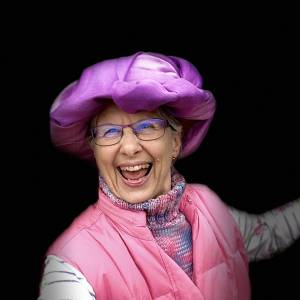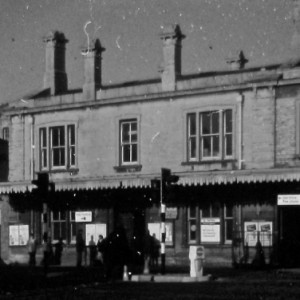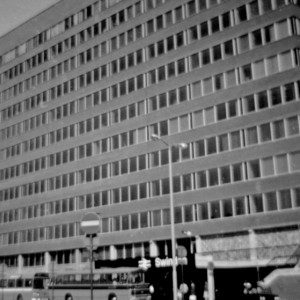A SEAT WITH A VIEW - NEAR SWINDON RAILWAY STATION
We had a great service at Church this morning, when three new Elders were welcomed into the Leadership Team and we even had chocolate cake as well as biscuits afterwards with our coffee!
I had noticed a few days ago, when Mr. HCB dropped me off at the station on my way to Bath, that there were lots of seats around the area in front of the station, so thought they would make an ideal subject to use for my Seat With A View challenge as there are also many interesting buildings around this area.
Swindon station opened in 1842 and until 1895 every train stopped at Swindon to change locomotives. The first recorded refreshment rooms were recorded at Swindon and these were divided according to class and it is thought that even the current King and Queen had stopped to take refreshments. Swindon is on the Great Western line and is 77 miles from London - with stops at Didcot and Reading. It also serves stations to the south west such as Bath and Bristol and on down to South Wales and of course stations in Devon and Cornwall.
There was originally a station in Old Swindon, but this closed to passengers in 1961, whilst goods trains continued until 1964. The line was removed and is now railway path, and part of the National Cycle Network that runs round the south of Swindon on a high embankment, joining with the Western Flyer and Coate Water. Although there isn’t a tarmac surface on this path, it is reasonable in most weathers and is a useful route to get from east to west of the town without going into the town centre and of course, with the exception of bicycles, is traffic-free.
The original building at the main station at Swindon was demolished in 1972, so the photographs I have put in as extras, taken by Mr. HCB’s father must have been taken prior to that date, probably in the late 1960s. He used to take his little instamatic camera and go on a “walkabout” around various places in the town, and although the quality is not that good, we are glad to have the slides he took - he used to say we needed to take these to remind us of what the town used to look like - such a wise man! He obviously went back after the station was demolished and rebuilt in 1972 as the other extra shows the modern station and office block erected on the site of the old station - featureless and quite ugly compared to the old station building.
Swindon Town station was used by thousands of people from Swindon during the annual Great Western Works “Trip” fortnight and enabled the workers to travel to the coast and other holiday destinations; many of those travelling would have had either free passes or privilege tickets that were much cheaper than full price tickets. I remember that the Solicitors’ office I worked in during the early 1970s always closed on Trip Wednesday - in fact, most of Swindon shut down on that particular day and Mr. HCB tells me that for those who possibly could not afford to go away for a week or a fortnight, used to go on “special” trains to various places.
The station was refurbished again in 2011/12 when it had a £1.75m facelift. There is now a large concourse as you walk towards the entrance with benches and trees leading towards the station - Mr. HCB was very kind and sat on one of the benches on this very cold and windy Sunday afternoon - he is such a great model and I must say, never grumbles when I ask him to help me out!
The general area is named after Sir Daniel Gooch, who was born in 1816 and died in 1869. He was a Locomotive Assistant to Isambard Kingdom Brunel and laid out the original Swindon Railway Works. He designed many locomotives and was also a Local Member of Parliament. He became Chairman of the Great Western Railway in 1865. Because of his many accomplishments, it is fitting that this area is named after him.
Many people use this station for their daily commute to Bath, Bristol, Reading and London, so particularly early in the mornings, there are always lots of people about. Because of closures on the nearby M4 motorway, there were a lot of people about today, which is quite unusual for a Sunday. Since the advent of computers, not quite so many people buy their tickets “on the day” because it’s easier to buy online, but at least they still have “real people” behind the counter and one of my favourite ladies, who used to serve me when I was at work in Bath, is Jan, and I still try and see her whenever I use the station now. I even gave her a heart last week!
On the concourse stands what is known as The Jubilee Clock, shown in the middle left of the collage, although its original name was the Millennium Clock. It was designed by Edwin Wright and made by the Cumbrian Clock company and looks like a giant eye-ball. It was commissioned to celebrate the Golden Jubilee of our present Queen It was first installed in the town centre in 2003 but never seemed to work that well, much to the annoyance of many shoppers. After the refurbishment of the station in 2012, it was obviously thought that the clock would look better near the station, so it was moved.
At the top of the steps leading to what always used to be called The Milk Bank, where many generations of train spotters used to go I was able to get a good view of the new station building and also the Jubilee Clock. I couldn’t find any explanation as to why it was called The Milk Bank, but Mr. HCB said they used to go up there for their train spotting when they didn’t have a penny to get up onto the actual station.
Opposite the station is a public house called The Queens Tap Hotel, shown at the top and middle right - and it is a very imposing looking building, although I doubt many people even notice it in their rush either to get to or from the station, but apparently, it is one of the oldest pubs in what was formerly the Swindon Railway Village and would have been a convenient place to stop and have a drink for thirsty commuters. Again, I was able to take several photographs from the top of the steps looking down on this particular pub. Perhaps the Queen even stopped here, who knows?
Across the road is another public house, the land for which was originally purchased by Arkell’s the local brewery in 1869, where their first purpose-built pub was erected and named The Great Western Hotel, shown at the bottom left and middle of the collage. This is another imposing Grade II Listed building and it looked very good from my vantage point way above it. Apparently, the station porters were happy that this was given a licence in 1869 as they noted that the Queens Tap Hotel was charging the extortionate sum of Tuppence for a pint of beer.
As I was writing this, I remembered that I had my 21st birthday celebrations there in 1966 and another memory came flooding back. I had invited several friends for dinner as my parents did not “do” birthday parties; I remember the bar was a huge sheet of copper and I got quite a shock when I touched it - amazing how these memories come back to us!
Stables and a large wing of bedrooms were added in 1904 and the Great Western remained a hotel until 1973 when it was converted to a steak bar and restaurant and renamed The Noah’s Ark, a name that remained for ten years - I’m not sure why, but it was obviously considered “trendy” back then. In 1983 the name was changed back to The Great Western, but a re-fit in 1991 gave it yet another new identity and this wonderful old building re-emerged as the Flag and Whistle, a “nod” to a railway guard. I do wonder why these places keep having their names changed because yet again after a major re-fit in 2000, the once famous name synonymous with Swindon returned and the hotel re-opened as the Great Western or the GW as it is now called.
On my visit earlier in the week I had noticed that the building at the side of Aylesbury Street was in need of some TLC. I remembered that it used to be a laundry and as I lived quite near, would walk past there as a child on my way into town; I remember the smell given off as the laundry was washed and by the giant presses as the laundry was ironed and as the door (the green one in the photograph) was often open, I used to stop and look inside. I do remember too that it was very noisy and smelly so I don’t suppose I stayed long! Again, I was able to get some good shots of the building from the Milk Bank opposite and could even see the door where I used to look in.
When I investigated I learned that this Grade II Listed building was originally a cheese factory, and was built between 1841 and 1876 and owned by the Aylesbury Dairy Company. It supplied dairy products to London and obviously used the Great Western Railway, which was just opposite. There was a proposal for a small extension with a mill and butter dairy, but there is no evidence to show that this was built. A man asked me whilst I was taking photographs why I was doing it so I explained about Blip and my Seat Challenge. He told me the building used to be a laundry, which I said I already knew, but he didn’t know that it was a cheese factory before that, so it was good to share that with him.
The cheese factory closed in 1891 and after the contents were sold through public auction, it was converted and became the Swindon Steam Laundry Company. There was a delivery and distribution yard to the rear, lined with horse boxes and also a Carpet Beating room. There was also a Receiving and Sorting room for the dirty laundry, much of which could possibly have come from the Great Western Hotel next door and other hotels and even hospitals in the area. There were offices as well as a General Washing room, a Mangling, Drying and Ironing room with an Airing room that apparently occupied the entire first floor of the building. Once the laundry had dried, it was sent to the Finishing room and then the Packing room on the ground floor before it was sent out. The rear of the building contained a Women’s Mess room and a Hats and Cloak room and in those days, and according to photographic evidence, the laundry employed mainly women. I can remember my mother sending sheets to the laundry and when they came back, they were always wrapped up in brown paper and tied with string. They were obviously starched too, because they always felt very slippery when you got into the bed that had clean sheets.
In the 1960s and before it became a Listed Building, the building was still in use as a commercial laundry, and was altered and extended to the rear. The 1960s extensions that replaced part of the 19th century building, were demolished in 2012 and there is now a large car park on this land with only a fraction of the building remaining and where car cleaning and valeting takes place. I did speak to a lady who was obviously the manager and she told us that the hotel next door had applied to take over this building and they had to leave by the end of next week. She did allow us to go inside and have a look round, so I told her about when I used to come and look inside at all the work that went on in the laundry and she was very interested to hear that.
One of the photographs that I took from my high vantage point shows painted lettering that reads Southern Laundry but many of the windows have been bricked up and today there is no evidence of the steam laundry. I do hope that they don’t knock the building down, even if the hotel takes it over, as it will be more of our heritage lost.
“Preserve your memories,
keep them well,
what you forget
you can never retell.”
Louisa May Alcott



Comments
Sign in or get an account to comment.


